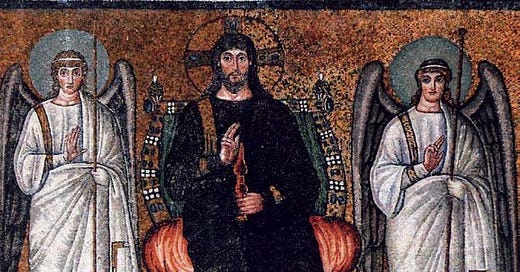Happy Postmillennial Easter
This Easter, when you sing, “Christ the Lord is Risen Today,” mentally insert the words “Christ the Lord is reigning today.”
Dear friends and supporters:
Inquirers sometimes ask me, “Can you point me to one text in the Bible that proves postmillennialism.”
I answer, “Start with Genesis 1:1.”
This is not glib snark. It’s precisely where one begins to prove the kingdom of God in Christ extends gradually in time and history and is consummated at Christ’s Second Coming ushering in the eternal state. The Second Coming does not reverse a severe spiritual decline. It is the final exclamation point on an incremental spiritual ascent.
To put it in technical theological terms: postmillennialism is the protological and eschatological dimension of a biblical philosophy of history. To put it in simple terms: Postmillennialism is the design of God’s unfolding will in the world.
David’s Transported Throne
But there are high points in this irreversible historical plan, and our Lord‘s resurrection is one of the main ones — perhaps the main one. No section of the Bible addresses his resurrection more extensively than 1 Corinthians 15, but a close second is Peter’s Pentecostal sermon in Acts 2. Note these arresting words :
Men and brethren, let me speak freely to you of the patriarch David, that he is both dead and buried, and his tomb is with us to this day. Therefore, being a prophet, and knowing that God had sworn with an oath to him that of the fruit of his body, according to the flesh, He would raise up the Christ to sit on his throne, he, foreseeing this, spoke concerning the resurrection of the Christ, that His soul was not left in Hades, nor did His flesh see corruption. This Jesus God has raised up, of which we are all witnesses. Therefore being exalted to the right hand of God, and having received from the Father the promise of the Holy Spirit, He poured out this which you now see and hear.
“For David did not ascend into the heavens, but he says himself:
‘ The LORD said to my Lord,
“Sit at My right hand, Till I make Your enemies Your footstool.” ’
“Therefore let all the house of Israel know assuredly that God has made this Jesus, whom you crucified, both Lord and Christ.” (vv. 29–36)
Peter quotes a Davidic psalm (16:8–11) to prove that Jesus Christ’s bodily resurrection and ascension fulfilled God’s promise to David that Israel’s final King would spring from David’s very loins, and that this King would reign not only over Israel but also over the entire earth. In other words, Christ is the Davidic King whose throne has been transported from the earthly Jerusalem to the heavenly Jerusalem (Heb. 12:22–29), and his realm is not only ancient Israel but the entire created cosmos.
Moreover, that rule will not end until all of Christ’s enemies are made his footstool. This is an ancient metaphor. When a king or his military commander vanquished his enemies in battle, he would force his vanquished counterpart to the ground and place his foot on their head or neck to symbolize his victory (note also this language referring to Christ’s defeat of Satan in Genesis 3:15).
No Standalone Miracle
In Peter’s inspired interpretation of the OT, the resurrection is not a standalone miracle. It is a high point in a series of redemptive-eschatological events, culminating in Christ’s victorious kingdom at the end of history. Christ rose bodily in victory; ascended to the heavens, where he took his throne and is currently ruling the world; and will conclude that rule only when all his enemies have been subordinated.
Christ’s resurrection, therefore, may never be decontextualized. Just as too many Christians speak only of Christ’s death as taking away their sins, not recognizing that the resurrection is no less essential to our salvation, so they celebrate at Easter a standalone resurrection, not understanding that it is an extricable link to Christ’s ascension and present, ongoing reign. Therefore, to celebrate Easter is implicitly also to celebrate the present, cosmic reign of Jesus Christ. He rose to reign.
The Law-Gospel Controversy
These days we are hearing more and more about the Law-Gospel distinction. We are informed that the Bible consists of two foundational “words” or messages — Law and Gospel. We are told that the entire Bible can be divided into these two messages. We are led to believe that these two messages, though each is God’s Word, are antithetical to each other. We are apprised that the Law-Gospel distinction is the standard, historic Protestant view. We are warned that to mix Law and Gospel is to undermine salvation by grace and diminish God’s ethical standards for man. We are given to understand, to put it most starkly, that to deny the Law-Gospel distinction will lead to “a blasphemous assault of the religious integrity of Jesus himself.”
This booklet is written to show that properly understood, law and gospel are fully compatible and that the traditional Law-Gospel distinction cannot pass serious biblical muster.
Get the hard copy and digital copy here.
The Sequence of Redemptive History
First Corinthians 15:22-28 depicts this great theological link also. Here Paul is laying out the sequence of redemptive history. He teaches Christ is the “first fruits” of the resurrection (v. 20). In other words, the final resurrection began with Jesus Christ. The great harvest of the resurrection, coming up from the ground in eternal incarnate life, awaits the end of history.
Presently Christ is reigning until he puts all of his enemies under his feet (v. 25, there’s that foot-head metaphor again). Then comes the end of history and inception of eternity (v. 24).
In other words, the sequence is: Christ died, and rose, is now presently reigning, and when his enemies are comprehensively subordinated, we, too, will rise from the earth as a great harvest, just as he was as our first fruits.
The Second Coming does not reverse a severe spiritual decline. It is the final exclamation point on an incremental spiritual ascent.
There’s no place in this redemptive sequence for a literal thousand-year reign after Christ returns. The reign is happening now. This means Christ will return after the kingdom advancement, known as the “millennium” indicated in Revelation 20. (For more biblical exegesis, see my A Postmillennial Primer: Basics of Optimistic Eschatology.) Therefore, Christ’s Second Coming is post-millennial. Easter is a postmillennial holy day.
Conclusion
Every Easter, we hear amid the depravity and chaos of the postmodern world the generic encouragement that Jesus rose from the dead, so our hearts can be filled with joy.
But Easter should inspire much more than generic encouragement. It should imbue us with the rock-solid knowledge that the crucified and risen One has ascended to the heavens and is presently reigning, incrementally beating down his enemies despite their fierce opposition.
In the riveting extended metaphor of Revelation 12, the woman who bears the infant King that ascends to heavens, escapes to the wilderness, and Satan, that old dragon and his hosts, are expelled from heaven to the earth and unleash their frenetic hatred of the woman by persecuting the saints in the earth.
The merciless hostility toward the saints is not proof Satan is winning, but that he is losing. The risen Lord is reigning and is gradually crushing Satan and his minions. Satan knows his days are numbered.
This Easter, therefore, when you sing, “Christ the Lord is Risen Today,” mentally insert the words “Christ the Lord is reigning today.”
This, too, is what we celebrate at Easter.
Personal
Sharon and I are finally arriving home after a long Southeastern tour. It was great to see many of you.
A reminder to pray that we'll be able to release the following works later this year: John Frame’s collected sermons Widen Your Hearts. The reprint of my New Flesh, New Earth: The Life-Changing Power of the Resurrection, and The Sanctified State: Politics in the Christian Worldview.
Please support CCL today if you can. Or enlist more paid subscribers to this e-letter.
Yours for the King,
Founder & President, Center for Cultural Leadership
Worldview Youth Academy in Tennessee
Friends, I hope you’ll join me this summer in Tennessee for this worldview event. Also, please consider sponsoring high school students for this transformational time.
Explore here.
Listen here.
More great stuff
The Center for Cultural Leadership site is here.
My Amazon author page (print and digital) is here.
My I-Tunes sermons, lectures and podcasts are here.
You can find my sermons and lectures at my YouTube channel.
Sign up to get my blog updates here.
Here’s my Twitter feed.
If you want to get the free exclusive hard copy publication Christian Culture, please send me a Facebook private message.
The CCL phone number is 831-420-7230.
The mailing address is:
Center for Cultural Leadership
P. O. Box 100
Coulterville, CA 95311









